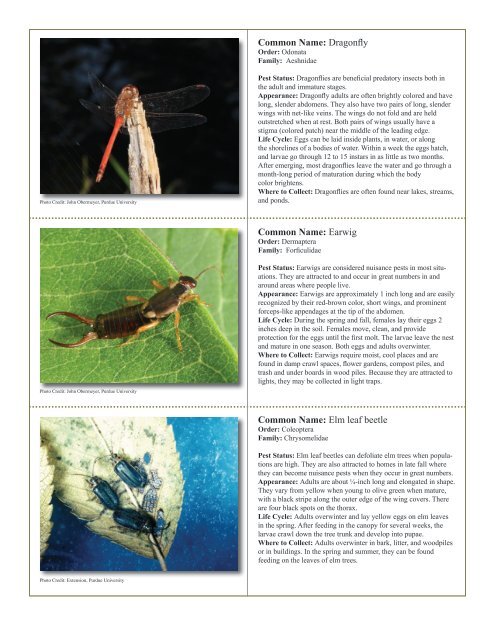to download pdf - Purdue Extension Entomology - Purdue University
to download pdf - Purdue Extension Entomology - Purdue University
to download pdf - Purdue Extension Entomology - Purdue University
Create successful ePaper yourself
Turn your PDF publications into a flip-book with our unique Google optimized e-Paper software.
Common Name: Dragonfly<br />
Order: Odonata<br />
Family: Aeshnidae<br />
Pho<strong>to</strong> Credit: John Obermeyer, <strong>Purdue</strong> <strong>University</strong><br />
Pest Status: Dragonflies are beneficial preda<strong>to</strong>ry insects both in<br />
the adult and immature stages.<br />
Appearance: Dragonfly adults are often brightly colored and have<br />
long, slender abdomens. They also have two pairs of long, slender<br />
wings with net-like veins. The wings do not fold and are held<br />
outstretched when at rest. Both pairs of wings usually have a<br />
stigma (colored patch) near the middle of the leading edge.<br />
Life Cycle: Eggs can be laid inside plants, in water, or along<br />
the shorelines of a bodies of water. Within a week the eggs hatch,<br />
and larvae go through 12 <strong>to</strong> 15 instars in as little as two months.<br />
After emerging, most dragonflies leave the water and go through a<br />
month-long period of maturation during which the body<br />
color brightens.<br />
Where <strong>to</strong> Collect: Dragonflies are often found near lakes, streams,<br />
and ponds.<br />
Common Name: Earwig<br />
Order: Dermaptera<br />
Family: Forficulidae<br />
Pho<strong>to</strong> Credit: John Obermeyer, <strong>Purdue</strong> <strong>University</strong><br />
Pest Status: Earwigs are considered nuisance pests in most situations.<br />
They are attracted <strong>to</strong> and occur in great numbers in and<br />
around areas where people live.<br />
Appearance: Earwigs are approximately 1 inch long and are easily<br />
recognized by their red-brown color, short wings, and prominent<br />
forceps-like appendages at the tip of the abdomen.<br />
Life Cycle: During the spring and fall, females lay their eggs 2<br />
inches deep in the soil. Females move, clean, and provide<br />
protection for the eggs until the first molt. The larvae leave the nest<br />
and mature in one season. Both eggs and adults overwinter.<br />
Where <strong>to</strong> Collect: Earwigs require moist, cool places and are<br />
found in damp crawl spaces, flower gardens, compost piles, and<br />
trash and under boards in wood piles. Because they are attracted <strong>to</strong><br />
lights, they may be collected in light traps.<br />
Common Name: Elm leaf beetle<br />
Order: Coleoptera<br />
Family: Chrysomelidae<br />
Pest Status: Elm leaf beetles can defoliate elm trees when populations<br />
are high. They are also attracted <strong>to</strong> homes in late fall where<br />
they can become nuisance pests when they occur in great numbers.<br />
Appearance: Adults are about ¼-inch long and elongated in shape.<br />
They vary from yellow when young <strong>to</strong> olive green when mature,<br />
with a black stripe along the outer edge of the wing covers. There<br />
are four black spots on the thorax.<br />
Life Cycle: Adults overwinter and lay yellow eggs on elm leaves<br />
in the spring. After feeding in the canopy for several weeks, the<br />
larvae crawl down the tree trunk and develop in<strong>to</strong> pupae.<br />
Where <strong>to</strong> Collect: Adults overwinter in bark, litter, and woodpiles<br />
or in buildings. In the spring and summer, they can be found<br />
feeding on the leaves of elm trees.<br />
Pho<strong>to</strong> Credit: <strong>Extension</strong>, <strong>Purdue</strong> <strong>University</strong>
















